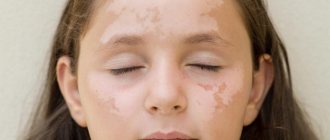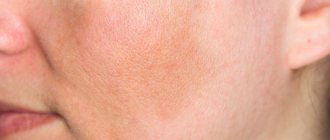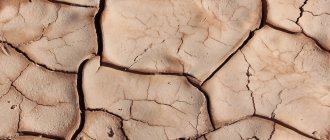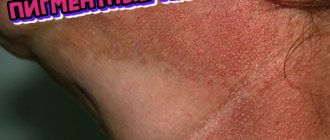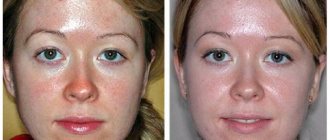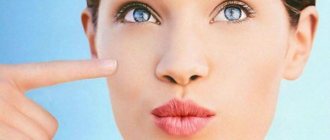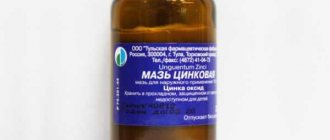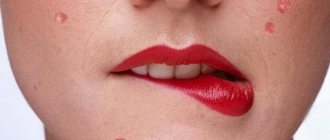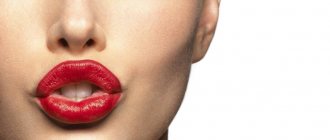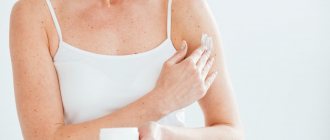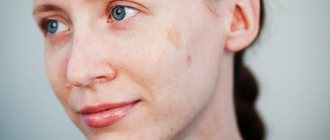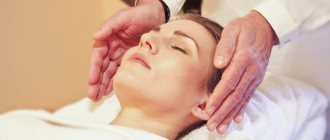White spots on the skin are not an independent disease, but can be a symptom of a dangerous disease.
We will talk about where white spots on the skin come from, how to find the cause of their appearance and how to treat them in this article. See photos of various diseases that manifest themselves as white spots.
How do white spots on the skin appear and where do they come from?
Leucoderma haunts women, men and children, regardless of age
White spots are a disorder of skin pigmentation, a pathological process that results in a decrease or disappearance of the level of melanin (coloring pigment) in the skin.
Doctors call white spots on the skin leukoderma, hypochromia, leukopathy, hypopigmentation or hypomelanosis.
The starting material for the formation of melanin is tyrosine (amino acid).
We either get tyrosine from food, or it is formed by an amino acid such as L-phenylalanine.
It is affected by pineal gland hormones or the enzyme phenylalanine-4 hydroxylase. This process is complex and is controlled by the nervous and endocrine systems.
If there is a malfunction in it, melanin in the cells stops accumulating and pigmentation is disrupted. This phenomenon is called skin dyschromia. White spots are one of the variants of dyschromia.
Leucoderma haunts women, men and children, regardless of age.
Also, white spots on the skin of various types can be a symptom of other infectious and non-infectious diseases. We'll talk about this in more detail below.
Causes of white spots in children
The appearance of white formations can be observed on a child’s skin when:
- A sharp change in hormonal levels. Often such changes are recorded in newborns.
- Accumulations in the baby’s body of estriol, a female hormone that penetrates the fetal body during intratubal development. An increased concentration of this substance is manifested by clinical symptoms, one of which is the presence of pimples, both single and multiple.
- Adaptation of the sebaceous glands to the increased work of the child’s body. As a result, rashes appear on the skin of the body, which go away on their own after a few weeks.
Important! If small white rashes in a baby do not disappear within two to three weeks, you should definitely see a pediatrician. You cannot treat your baby with drugs for adults. The doctor will first determine what caused the pathological process, and then prescribe therapy appropriate for his age and weight.
Character of pigmentation
Based on the nature and characteristics of white spots on the skin, one can draw conclusions about the disease that caused them.
Here are just some descriptions and reasons:
- The color of the spot can be light pink or have a yellowish tint
A white spot with a red rim . A red rim around the spot is a sign of various problems in the body, infectious diseases or allergies. Another white spot with a red rim appears when a wound is healing, a burn, or as a result of serious stress. Spots with a red rim can occur due to ringworm, athlete's foot, trichophytosis, or mycosis contagiosum. The white color often appears due to plaque on the spot.
- Flaky white spots . The color of the spot can be light pink or have a yellowish tint. Often these spots are rough to the touch. The cause of such spots may be pityriasis versicolor, caused by a fungus. Less commonly, such spots are caused by psoriasis.
- Itchy white spots. These have a scaly surface, and in the cold season they can become inflamed. The diameter of the spots is from 1 to 4 cm, appearing on the arms and legs. The culprit is pityriasis alba. Dermatologists believe that pityriasis alba is caused by a fungus called Malassezia, which produces substances that block the passage of UV rays to the skin. Alba may develop in people with asthma, eczema or atopic dermatitis.
- Convex white spots . At the initial stage of development of lichen, all spots on the skin have a convex shape. The second reason is benign or malignant skin formations.
- Spots on the skin with white edges . The color may be pink, brownish or red, and the white edges are jagged. The appearance of spots is accompanied by itching and the desire to scratch the skin. These are also lichens, fungal diseases, streptoderma and dermatitis. Sometimes it's just a healing burn.
- White dry spots on the skin . They usually peel off. Here again, pityriasis versicolor or the more rare hypomelanosis are to blame. If they don't peel, get tested for vitiligo.
- Small white spots . If they are located in the form of a rash and have an uneven surface, mycosis is again to blame. Another cause of such spots is non-pigmented melanoma. This is a skin cancer that can be difficult to detect. Small spots with it have an irregular shape and clear boundaries, the hair located on such spots also turns white.
- White spots when pressed . Skin diseases and fungi are not to blame here. A symptom of a white spot is a phenomenon when a spot on the skin does not disappear for a long time after pressing with a finger. Causes: impaired sympathetic innervation or vascular insufficiency.
What is leucoderma
Leukoderma (syphilis) is the second stage of the sexually transmitted disease syphilis. It occurs in women who have been struggling with the disease for a long time. Considered a nervous disorder. The affected area is the neck, not far from the parietal and temporal areas of the skull. Spots may appear on the shoulders and back.
The first symptoms develop two months after infection with syphilis. The stains may remain for many years. The symptoms are as follows.
1) The pigmentation disorder spreads throughout the body except the feet and palms. Spot color: pink, white, red, yellow. Symptoms of a cold are possible: fever, weakness, feeling hot and cold.
2) Hair loss and loss of most of the hair follicles.
3) Spread of the disease to the control of the vocal cords. Heaviness in the voice.
4) The spots are not subject to inflammatory processes and surface peeling.
| Spotted leucoderma | Lace leucoderma |
| The spots are located over the entire surface of the body. They don't merge. The distance is small. | The skin completely loses its ability to pigment. Small spots of normal skin remain. |
It is possible for spotted leukoderma to flow into lacy leukoderma.
Treatment of the disease involves eliminating the cause of its occurrence - syphilis. Use of antibiotics is used. It is important to remember that treatment is a long process that requires patience.
Causes of white spots
Causes of white spots:
- Any inflammatory skin diseases;
- Endocrine diseases;
- Diseases of the central nervous system;
- Infections (syphilis, leprosy, white, red flat, scaly, multi-colored lichen);
- Consequences of inflammation (for burns or skin ailments accompanied by inflammation (eczema and psoriasis);
- Medicinal and toxic causes;
- Congenital. These are all forms of albinism (there are 10 in total), Bloch-Sulzberg melanoblastosis, tuberous sclerosis. They are often provoked by congenital pigment incontinence, Wolf syndrome, Waardenburg and Ziprovsky-Margolis syndromes;
- Immune causes (scleroderma, halo-nevus, systemic lupus erythematosus, vitiligo - with these ailments the immune system itself can destroy melanocytes).
Vitiligo
The disease vitiligo often leads to depigmentation of the skin. Why this disease appears and what causes it is not completely known. However, most experts are of the opinion that vitiligo is a dangerous autoimmune disease in which the immune system begins to independently destroy healthy cells that produce melanin (the hormone responsible for pigmentation). As a result, the skin is covered with milky white spots, and there are no unpleasant effects, itching or other troubles. Among the main risk factors:
- Genetic predisposition.
- Autoimmune and hormonal imbalances.
No one is immune from the sudden appearance of white spots due to such a disease. Most often they are localized in open areas of the body, in the armpits and groin. They can be found on the skin near scars, scars or moles.
There are still no effective remedies and drugs to combat vitiligo, although experts have developed a number of medications that reduce the progression of symptoms of the disease.
During treatment, it is necessary to use corticosteroid ointments and antioxidants, which will promote the active production of melanin. In addition, physiotherapeutic methods (PUVA therapy, laser and placental therapy) are especially popular. The techniques activate melanocytes, improving metabolic processes and reducing the severity of spots.
Among the most effective solutions against the symptoms of vitiligo is photochemotherapy with psoralen. The treatment course consists of taking psoralen in the form of tablets or ointments, after which the skin is treated with ultraviolet light. To carry out the procedure, you must visit a specialized clinic where all the necessary equipment is available. However, the cost of treatment is quite high, and the risk of developing serious complications is very high.
Therefore, before starting therapy, the patient must undergo a comprehensive examination to determine possible contraindications.
Experts can attribute another procedure - depigmentation , but it will be effective only in cases where the spots have covered more than 50 percent of the skin. For treatment, it is enough to apply special preparations to the skin that have a lightening effect. With their help, you can discolor those areas with pigment.
Diseases
There are many diseases that can cause white spots to appear on the skin, and not all of them affect only the skin.
Here is a list of the most “popular” ailments:
- Vitiligo. The main symptom of the disease is milky white spots on the skin. They most often appear around the mouth, eyes and ears, on the arms and legs, in the groin area and on the buttocks. Their boundaries are clearly defined, the color may be bluish, and sometimes they have a pigmented outline or border. May be accompanied by dermatitis, baldness, inflammation of the retina, sweating disorders and skin sensitivity in white areas. Among the risk factors, one can note not only the reasons mentioned above, but also poor nutrition of the skin, its injuries and burns (can provoke disruptions in the immune system), liver and gastrointestinal diseases, and taking certain medications. Most patients begin to develop between the ages of 10 and 30 years. The causes of the disease are still being investigated:
- One of the reasons is called autoimmune failures. Thus, antibodies destroy healthy cells, including skin pigments. The connection between vitiligo and impaired immunity is evidenced by the fact that this disease often occurs in those who suffer from rheumatoid arthritis and systemic lupus.
- Another possible cause of vitiligo is problems with genetics.
- They can provoke vitiligo and malfunctions of the thyroid gland (goiter).
- Pityriasis versicolor. Fungal disease. It is caused by the round yeast-like fungus Pityrosporum orbiculare, the oval Pityrosporum ovale and the mycelial Malassezia furfur. All these are forms of one fungus and they can change freely into each other. They live quietly on human skin and do not harm it, and begin active activity only under certain conditions. The reasons for its appearance are insufficient body hygiene, a change in weather to warmer, and simply a person’s predisposition to fungal diseases. Most often occurs in young men and adolescents, and is more common in warm countries. The main symptom of pityriasis versicolor or pityriasis versicolor is white and scaly spots on the body that have an irregular shape. They arise due to the fact that fungi disrupt the functioning of melanocytes.
- Idiopathic guttate hypomelanosis . A benign variant of leukoderma, in which small depigmented spots appear on the body and face. Most often occurs in women over 50 years of age. The word “idiopathic” in the name means that the cause of the disease is unknown. But the fact that most often such hypomelanosis appears in adults indicates that one of its causes is photoaging of the skin. Confirmation of this can be found in statistical data: most sufferers from guttate melanosis are among those with fair skin (light type 1 - 3). Some dermatologists consider the cause of the disease to be histocompatibility antigens HLA-DR 8. Dermatologists do not rule out the hereditary nature of melanosis. The main symptom is small (up to 1 centimeter in diameter) porcelain-colored spots. They do not increase in size and have clear boundaries. The hair on the affected skin does not change color, which is how melanosis differs from vitiligo. The back of the lower leg is affected first, then the forearms, chest and upper back.
- Fungus on the skin. White spots appear due to fungal ringworms and thrush. They are usually accompanied by itching. There are a lot of fungi that live on our body (and inside it). But they can begin active activity in the following cases:
- with excess weight;
- after treatment with antibiotics;
- due to the habit of not drying the skin after bathing;
- for diabetes;
- in contact with animals and people sick with mycosis;
- when using things contaminated with mycoses;
- when wearing too tight clothes and shoes;
- with weakened immunity;
- with insufficient hygiene;
- during pregnancy.
- Pityriasis rosea . Aka Zhiber's disease. It is believed to be an infectious skin disease, but there is little precise information about its origin. The causative agent is unknown, but there is a version that it is a herpes virus. Little more is known about the contagiousness of the disease. Dangerous during pregnancy, as it can cause spontaneous abortion. Usually the disease begins with a couple of maternal plaques, which are distinguished by a bright pink color. After a few more days, light pink, almost white, rashes appear all over the body. In the center of the spots there is peeling, slight itching, a slight increase in temperature and enlarged lymph nodes. If left untreated, pityriasis rosea develops into a more severe form called Lichen annulare Vidal. After the rash resolves, as with any other skin disease, pityriasis rosea may leave white spots.
- Pigmentless nevus . It is also an intradermal mole in which there are not enough pigment cells. It is a skin neoplasm, and a benign one. It does not cause any particular concern, does not grow, and very rarely develops into a malignant neoplasm. Most often it occurs in children.
- Leprosy . Now the phenomenon is extremely rare. Doctors call it chronic granulomatosis. Caused by mycobacteria (Hansen's bacillus or mycobacterium lepromatosis). It affects not only the skin, but also the central nervous system, reproductive system, eyes, and larynx. What do the white spots have to do with it? They are the first symptom of leprosy. They are either too sensitive to stimuli (hyperesthesia) or not sensitive at all (paresthesia). After 2–3 days, this hypopigmentation disappears on its own.
- Syphilis . Here we are talking about syphilitic leukoderma. Treponema pallidum, as a carrier of syphilis, is transmitted not only through sexual contact. The rash with syphilis has its own characteristics. Usually spots appear with secondary recurrent syphilis. They are best seen in side lighting; they can vary in size, but their average diameter is about a centimeter. They are located in the neck, on the arms, on the torso, less often on the stomach, back or lower back. There is no itching, pain or other discomfort from them.
Pigmentless nevus
Idiopathic guttate hypomelanosis
Fungus on the skin
Leprosy
Pityriasis versicolor
Lichen Rosea Vitiligo
Syphilis
What is vitiligo
Vitiligo is a chronic disease characterized by the appearance of skin discharge. White pigment spots on the body are the result of insufficient melanin.
Risk factor: men and women under twenty-six years of age. Scientists have not identified an official theory for the occurrence of pathology.
Vitiligo does not cause symptoms other than cosmetic problems. After the appearance of a new discharge, light scratching of the damaged area, comparable to insect bites, is acceptable.
| Symptoms | Internal processes | External Processes |
| Primary manifestation | The white area contains melanocytes that lose their functional properties. | Arms, legs, face are covered with the first spots. Appearance time: one hundred and twenty minutes. |
| Change in skin tone around the damaged area | Functional cells of the epidermis restore pigmentation, forming an inflammatory process. | Darkening of adjacent areas of the epidermis. |
| Growth of age spots | Infection of neighboring epidermal cells. | Acceleration of the process of vitiligo. Draining stains. |
| Globalization of vitiligo | The formation of spotty discharge is everywhere. The exception is the feet and palms. Areas of skin do not produce melanin. | The affected area is bending, wounded parts of the body. |
| Damage to hair follicles in damaged areas | Loss of bulb function. | Hair bleaching |
| Mesh formation | Small, closely spaced spots. | The affected area is the reproductive organs, hips. |
External and internal problems of the body that cause vitiligo:
- abnormal functioning of the digestive system;
- weak unprotected immune system;
- disruption of endocrine system processes caused by false messages from the pituitary gland;
- metabolic disorders;
- diseases of the endocrine system of internal secretion;
- stress load on the nervous system;
- prolonged daily sunbathing, causing severe tanning and burns;
- mechanical damage to skeletal bones;
- rehabilitation of diseases caused by infection;
- Excess of metals, toxins, phenol;
- Genetic predisposition.
| Therapy | PUVA therapy | Melagenin | Hormonal ointment |
| Property | Psoralen is an integral part of drugs. Stains are removed with ultraviolet rays. | Restoration of melanocyte functions. Creation of new cells. | Protopic and Elidel help treat the disease. |
Other situations
Sometimes white spots are not associated with endogenous diseases or skin diseases, or are rather indirectly associated with them.
Here are a few such cases:
- Sometimes pityriasis versicolor is to blame for the appearance of light spots after sunbathing, or less often - sunscreen
White spots after sunbathing . They can occur in areas of the skin that were once injured (scars, burns, etc.). Sometimes pityriasis versicolor is to blame for the appearance of light spots after sunbathing, and less often, it’s tanning cream (if it’s not distributed correctly). Other causes of white spots after tanning are due to a lack of melanin. Read above about the causes of this problem and contact a dermatologist.
- White spots during pregnancy . There are two reasons for their appearance. White spots on the legs may indicate problems with blood circulation and that the lower extremities need compression. The second reason is the same failure of the entire hormonal system that is typical for pregnancy. It also affects the production of melanin. Such spots will go away on their own after childbirth and they do not pose any danger.
- Light areas of skin after hydrogen peroxide. Peroxide is a good cosmetic product for getting rid of age spots, for cleansing the skin and fighting acne, but when used, an oxidation reaction occurs, which leads to a chemical burn and hypopigmentation. It's not easy to get rid of it. It will be easier to prevent such burns: It is better not to apply peroxide in its pure form (you can only apply it to individual pimples or dark spots).
- Keep it on your skin for no more than ¼ hour.
- Add softening ingredients (vegetable oils, honey, yolks) to masks with peroxide.
- After rinsing, be sure to soften the skin with a nourishing cream.
Prevention of points
To avoid the formation of white spots under the skin on the face and body area (for example, on the foot, on the palm, in the area of the fingers, under the eyes, etc.), you should follow the following recommendations of dermatologists:
- cleanse the skin in the morning and evening hours;
- select high-quality cosmetics to care for the epidermis;
- do not use aggressive products that can cause burns or irritation;
- do not touch your face with dirty hands;
- give up bad habits;
- contact a dermatologist in a timely manner (whitish bumps and rashes on the body and face in men, women and children are a good reason to visit a specialist);
- monitor the proper functioning of the gastrointestinal tract and thyroid gland;
- strengthen the body's defenses;
- spend more time in the fresh air;
- limit the consumption of unhealthy, heavy foods.
It happens that rashes appear on tanned skin due to exposure to ultraviolet radiation and burns. Also, due to too much exposure to the sun, the skin after tanning shows red areas that turn into white blisters. To keep your skin healthy, you need to avoid contact with ultraviolet radiation, lubricate your body with sunscreen and not sunbathe from 11 a.m. to 4 p.m. People who have unsightly spots and burns on their skin after tanning should use healing creams (for example, Panthenol , which costs 150 rubles).
Where might they appear?
Where the white spots appear depends on the disease that caused the hypomelanosis.
Here are a few special cases:
- White spots on the stomach and back may indicate allergic reactions and skin diseases
white spots on the inside of the legs and arms appear due to lichen and fungal diseases;
- white spots on the legs, noticeable when pressed, are a sign of problems with blood circulation;
- Idiopathic guttate hypomelanosis begins with white spots on the lower leg;
- white spots on the stomach and back may indicate allergic reactions and skin diseases (psoriasis);
- white spots on the neck, called the necklace of Venus, are a symptom of syphilis;
- spots on the face (especially around the mouth) are a signal of the onset of vitiligo;
- white spots on the scalp - indicates focal albinism, which manifests itself in the appearance of white spots;
- white spots on the lips under the skin are signs of candidiasis, stomatitis, colds (caused by the herpes virus). White spots in the form of granules are diagnosed with Fordyce disease;
- small white pimples under the eyes - milia (popularly called millet) appear with increased sebum secretion;
- white spots on the palms appear more often with vegetative-vascular dystonia, vitiligo, leukoderma, partial albinism;
- white spots on the genitals are characteristic of inflammation and infectious diseases, such as candidiasis, papillomavirus, and also appear with decreased immunity, diabetes, and HIV infection.
- a separate white spot on any part of the body can indicate many skin diseases: syphilis, leprosy, mycosis.
Diseases that provoke the appearance
White spots on the skin of the hands may also indicate the presence of a disease. We will now consider the characteristic features of the most common diseases in more detail.
This is very important because establishing the main cause of the appearance of white spots on the skin will greatly facilitate treatment
Vitligo
The disease belongs to the group of autoimmune pathological processes. It is characterized by the appearance of white and even milky spots of various shapes. These depigmented areas do not receive enough melanin and therefore become vulnerable to ultraviolet radiation. It is on them that burns often form.
To date, no effective drugs have been invented for this disease. To eliminate white spots under the skin on the hands, drugs are used that have the ability to improve the skin’s sensitivity to sunlight. After this, the skin is exposed to ultraviolet light. Laser therapy can also be used.
Leucoderma
The clinical picture of the disease is quite similar to the symptoms of vitligo. The skin does not produce enough melanin and therefore white spots form under the skin on the hands and more. Quite often, the cause of the formation of leukoderma is inflammatory processes in the body or disruption of the functioning of the nervous system. Observational data indicate that a hereditary factor or treatment with medications that the body does not accept can also cause white spots on the hands.
Leucoderma is characterized by the appearance of white spots of varying sizes and shapes. The peculiarity is that they have a dark border. The most vulnerable to this disease are people who have not reached the age of twenty-five.
Pityriasis alba
The disease manifests itself in the appearance of white spots on the hands. The reason for their formation is the Malassezia fungus. This pathological condition is not accompanied by any other pathological symptoms or sensations. Most often, lichen alba affects children under 16 years of age.
The causes of the disease are still unknown, and therefore there is no proven effective treatment regimen. However, despite this, seeking advice from a doctor is mandatory.
Pityriasis and rosea and ringworm
In other words, this disease can be called mycosis; it affects the superficial layers of the epidermis. Its formation is caused by an excessive amount of yeast-like fungus on the skin. The disease is not contagious, it occurs as a result of hyperhidrosis or as a result of puberty during adolescence (the most vulnerable representatives of the stronger half of humanity). The main feature is that the white spot on the arm or other part of the body peels off.
This pathological condition refers to diseases of infectious-allergic origin. It is characterized by the appearance of rough spots with a peeling process of different sizes. Its cause is infectious processes of a viral and bacterial nature.
https://youtube.com/watch?v=ydIbQGsf6nc
White spots in children
Very often parents ask the question: their child has white spots on his hands, what is it? So, the formation of white spots in children may indicate hypomelanosis; it usually manifests itself in the first days of life. The final cause of its formation has not been determined, but there is an opinion about the connection of the pathological condition with infectious diseases. Unfortunately, hypomelanosis can cause disruption in the development of the child and the functioning of the nervous system.
To combat this pathological condition, medications based on retinoids are used. In parallel with this, various cosmetic procedures are carried out.
Diagnostics
Consult a doctor even if changes in the skin do not cause any discomfort or inconvenience.
Treatment is carried out by a dermatologist or dermatovenerologist, other specialists (endocrinologist, gastroenterologist, neurologist, immunologist, rheumatologist) are optional:
- The diagnosis cannot always be made only by external examination of the skin.
To make a diagnosis, a dermatologist will take a look at your medical history, examine your skin, and find out if you have recently taken (and what) medications or been in contact with (and what) chemicals. The diagnosis cannot always be made only by external examination of the skin.
- For a more detailed diagnosis, a blood test is needed , which can identify both an infectious disease and problems with the immune system (with systemic lupus, antinuclear antibodies are detected in the blood).
- Another type of diagnosis is carried out using a Wood lamp , which is used in special darkened rooms. This method allows you to differentiate infectious diseases (lichen, eczema) and non-infectious ones.
- To clarify the data, you can undergo a biopsy and genetic tests.
- , ophthalmologist, geneticist and cardiologist is required to make a diagnosis
Hypovitaminosis
Guttate hypomelanosis manifests itself in the form of small, several millimeters in diameter, white spots on the skin. The spots look like drops - hence the name of the disease.
In early childhood, the disease can become a complication of severe infectious diseases. At the same time, damage to the central and peripheral nervous system and delayed mental and physical development may occur.
The skin in the area of the spots can be either smooth or rough, scaly, there is no itching. The spots usually appear on exposed areas of the body exposed to sunlight.
The disease is more common in people with fair skin.
In adults, guttate hypomelanosis occurs after forty years and is associated with natural aging of the skin.
Treatment
Often, treatment of white spots begins with treatment of the underlying ailment. If the reason is not very serious, they may go away on their own.
If leucoderma is of toxic origin, it is enough to stop contact with the substance that caused it.
First, complex treatment is always carried out using drugs and local agents.
The choice of such remedies depends solely on the reasons for the lack of melanin. Afterwards, normal skin pigmentation is restored and aesthetic defects are eliminated.
Pityriasis alba
Another common disease is pityriasis or pityriasis alba. The first symptoms are represented by the appearance of round spots of pale pink color on the face, neck and hands. In the early stages, the spots are convex, but soon they become flat and white in color. In the summer, the defect is especially noticeable, and especially against the background of tanned skin. When winter comes, the spots begin to peel off, and then the patient experiences unbearable itching and an inflammatory reaction.
The pathology especially often attacks children and adolescents, and the maximum distribution is present in areas with a warm and humid climate.
To return natural pigmentation to the skin after pityriasis, you should undergo a therapeutic course for several months, using ointments with a low content of steroid components, as well as a number of drugs based on pimecrolimus .
Medicines
They are prescribed depending on the cause of the appearance of white spots on the skin:
- For the treatment of lichen and other fungal diseases, the following tablets are considered the most effective: Lamisil. The active ingredient is terbinafine. It has a broad effect, stops the synthesis of stearins in fungi, which leads to their death. Contraindicated only in case of hypersensitivity to terbinafine. Price from 443 rub.
- Nizoral. It is also available in the form of tablets that effectively fight against mycoses. Stops the growth of the fungus, changes its cell membrane. Contraindicated for liver diseases, lactose intolerance and for young children (under 3 years). Price – from 790 rub.
- Orungal. Effectively fights against different types of lichens and fungi. Inhibits the key enzyme CYP 450 of fungi. Price from 2350 rub.
- Benzylpenicillin is effective against lichen and other skin diseases that cause the appearance of white spots. Contraindicated for epilepsy, hyperkalemia, arrhythmia. Available in the form of sodium or potassium salt. Price from 7 rub.
- Hydrocortisone (price from 150 rubles).
Ampicillin
Benzylpenicillin
L-phenylalanine
Hydrokartision
Lamisil
Nizoral
Oxacillin
Orungal
Prednisolone
Tyrosine
Each case of leukoderma is individual, so you may be prescribed the most unexpected medications.
Diseases of fungal origin
Among the most common and dangerous causes of loss of natural color and pigmentation is a chronic skin disease - pityriasis versicolor. The causative agent of this fungal infection is yeast, which rapidly forms colonies on the skin and produces azelaic acid, which affects melanocytes and blocks the production of melanin. As a result, the skin becomes covered with small round or oval white spots with clear boundaries. The deformation is especially noticeable against the background of tanned skin. Subsequently, the defect increases in size or completely merges, covering large areas. Sometimes the spots spread to the chest, shoulders, neck, back and even groin.
The mycelium of the fungus continues to loosen the surface layer of the epidermis, so over time the spots begin to itch and peel. However, the inflammatory response is still absent. During the cold season, the defect becomes dark, but after visiting the solarium, everything returns to its original place. A similar situation is observed in the summer, when after prolonged exposure to ultraviolet radiation the spots become especially pronounced. Because of these features, pityriasis versicolor is often called “sun fungus,” which is very common in people living in hot and humid climates.
The fungus cannot be transmitted to other people, since it is formed only due to a weakened immune system, excessive sweating, endocrine system disorders or disruptions in the natural microflora, which can occur with intensive use of antibacterial cosmetics.
At the same time, many experts argue that the risk of infection with pityriasis fungus is also present upon contact with a sick person. Therefore, if the disease is in an acute phase, take a number of precautions by providing the patient with dishes, bedding and hygiene products.
If a fungal infection has been detected, the dermatologist may be able to formulate a suitable treatment regimen, which is based on the use of local antifungal agents in the form of ointments and creams. In advanced cases, complex therapeutic treatment cannot be ruled out, when you have to take the following popular drugs:
PUVA therapy, UVB sessions
Both PUVA therapy and ultraviolet irradiation are light therapy methods.
They have proven themselves best in the treatment of the following skin ailments:
- vitiligo;
- psoriasis and parapsoriasis;
- dermatitis (atopic and seborrheic);
- lichen;
- lymphomas;
- many other rare skin conditions that can cause white spots.
PUVA therapy , also known as PUVA therapy, is a method in which diseased skin is irradiated using long-wave ultraviolet radiation.
This is combined with a photoactive substance (psoralens from the class of furocoumarins):
- You will notice signs of skin improvement after just 4 treatments.
First, you apply or ingest a psoralen product (take the drug with milk or bread).
- Then you go into the cabin and stay under the UV rays for several minutes.
- Another option is to take a psoralen bath a couple of hours after irradiation.
You will notice signs of skin improvement after 4 procedures, and remission after the course lasts from 18 months to 3-4 years. The course includes 20 sessions.
It also has a positive effect on the immune system. You can have from 2 to 4 sessions per week, and have a new consultation with a dermatologist every 14 days.
Contraindications:
- Hypersensitivity to psoralen;
- Diseases in which sensitivity to light develops (lupus erythematosus, porphyria);
- Melanoma;
- Pregnancy;
- Heart diseases.
UFO (ultraviolet irradiation) is another method of physiotherapeutic treatment. Its work is based on the fact that certain atoms and molecules selectively absorb light energy.
The molecules in the tissues are then in an excited state. This is how photochemical processes are launched in RNA, protein and DNA molecules.
Indications:
- For therapy to be successful, before starting it, the doctor will determine your biological dose of UV rays.
vitiligo;
- pyoderma;
- seborrhea;
- psoriasis.
For therapy to be successful, before starting it, the doctor will determine your biological dose of UV rays. The course lasts from 10 to 20 irradiations. They are held once every 2 days.
Contraindications:
- predisposition to bleeding;
- neoplasms (malignant only);
- tuberculosis (in the active stage);
- thyrotoxicosis;
- hypertension;
- exacerbation of intestinal and stomach ulcers;
- blood diseases (systemic);
- atherosclerosis (coronary vessels and arteries of the brain);
Procedures are carried out with caution for acute diseases of the skin, nasopharynx and inner ear, for skin tuberculosis and for wounds caused by anaerobic bacteria.
White spots on the body - how to treat in children
If you are concerned about the question: “How to get rid of white spots on the skin,” be prepared to take drastic measures and work hard. Treatment should be especially thorough when spots appear in children. The fact is that children's skin is very delicate and sensitive, so aggressive methods are ineffective and may even be harmful.
Among the most common diseases that cause the formation of age spots in children, hypomelanosis occupies a leading position. The problem is dyschromia of the superficial (horny) layer of the epidermis, which progresses in the early stages of the baby’s development, or after severe diseases of infectious origin. When treating hypomelanosis, you should use highly effective drugs - retinoids, which can slow down the process of depigmentation. And it is also important to perform a number of cosmetic procedures.
In addition, children often suffer from tumorous sclerosis. With this disease, the face becomes covered with large white spots, the diameter of which reaches three centimeters. The main location is concentrated on the face, skin of the arms and legs. In this case, the spots may indicate a more serious pathology, causing additional complications, including:
- Damage to internal organs.
- Mental retardation.
- Epilepsy.
Like adults, children are exposed to pityriasis versicolor, pityriasis alba or rosea, as well as many other diseases that are more serious in nature.
If you identify alarming symptoms and changes in pigmentation, show your child to a specialist as soon as possible so that he can establish a diagnosis and select quality treatment. Only with this approach can the problem be solved in a short time and without surgical intervention.
To prevent white spots from sunburn, limit your exposure to sunlight. Sunbathe in the morning or late afternoon, when there is little sun activity. The best time for sunbathing is from 8 to 11 am , or after 16 pm. At the same time, it is important to moisturize the skin with the help of special creams and lotions that will prevent overdrying.
Physiotherapy
Kinds:
- Do the procedure daily or every 2 days
The simplest physiotherapeutic method is heliotherapy . It's just a tan under the southern (or just summer) sun. Regular tanning under the sun also activates melanin synthesis. It is important to complete a whole course of sunbathing, that is, from 12 to 24 trips to the sea or to the river. Contraindicated in patients with cancer.
- Electrophoresis of copper . It mitigates side effects after PUVA and UVB. Complete the procedure daily or once every 2 days. The duration of electrophoresis is ¼ hour.
- Darsonvalization . The skin is exposed to pulsed current (frequency and voltage are high, strength is low). It is actively used in the treatment of vitiligo, psoriasis, eczema, dermatitis and many other skin ailments. Contraindicated in cases of cancer, skin tumors of any nature, epilepsy.
Skin graft
This method is recommended for vitiligo, when areas of hypomelanosis become too large and cannot be corrected.
Skin grafting can be:
- To carry out the transplant, the skin is cut off using a dermatome, the flap is immediately transplanted to the desired area and sutured
autotissue, when the patient’s healthy skin is used (for vitiligo - not the best option);
- allotissue – the skin of immediate relatives is used;
- cellular is a good option for vitiligo. It uses individual cells created in the laboratory.
To carry out the transplant, the skin is cut off using a dermatome, the flap is immediately transplanted to the desired area and sutured.
Another operation, melanocyte transplantation, is also gaining popularity.
It is carried out if the disease is stabilized and the spots have not grown for the last six months.
For transplantation, healthy melanocytes are taken from the skin on the buttocks (or other areas of the skin not affected by vitiligo), converted into a cell suspension and injected into the depigmented area, previously treated with dermabrasion or laser.
A special bandage is placed on top. Repigmentation occurs after 2–4 months.
There are several requirements for melanocyte or skin transplantation:
- you should not be anemic;
- the level of total protein should be below 60 g/l;
- protein coefficient level is greater than 1.
Ointments, shampoos, soaps, creams
This is not the most effective way to deal with white spots, because the problem is hidden much deeper than on the surface of the skin. But they can also help.
It is best to use ointments when dealing with spots caused by lichen or mycosis. If you are prescribed Nizoral, Orungal or Lamisil tablets, it is recommended to enhance their effect with similar ointments. The same goes for antibiotics.
Here are a few names of ointments that dermatologists prescribe for leukoderma of various origins:
- Methylpred (price from 350 rubles), alklometasone (price from 320 rubles). These are glucocorticoids in ointments. Can be used for vitiligo.
- Melagenin. A popular drug for the treatment of vitiligo. Available as a lotion. The basis of the product is human placenta extract. When using the product, the repigmentation process is accelerated, the skin absorbs ultraviolet rays and the formation of melanin is stimulated. A positive effect is also observed in cases with loss of pigmentation after psoriasis or burns and wounds. It is also effective for eczema and psoriasis. Price from 4400 rub.
- Betamethasone. A glucocorticoid agent that will be effective for both vitiligo and fungi. Price from 176 rub.
- Clotriamzole. Ointment with a wide spectrum of action. It will help get rid of causes of white spots such as lichen and fungal diseases; it is also effective for eczema and psoriasis. Price – 97 rub.
- Irunin. An antifungal agent with the active substance itracanazole. Inhibits the membranes of many fungi. Price from 352 rub.
Afloderm
Betamethasone
Irunin
Clotrimazole
Melagenin
Metipred
Elimination methods
How to get rid of snow-white spots on the face?
If an excessive number of such wen appears on the face, they can be eliminated in various ways:
- The use of bactericidal ointments for the formation of small inflamed lesions (“Erythromycin ointment”, “Clindamycin ointment”, “Dalacin” gel).
- The use of drugs aimed at reducing the secretion of the sebaceous glands (Skinoren Gel, Boro Norm cream, ointments based on zinc and tar).
- When large areas of skin are affected, ointments with retinoids are used (Klenzit S gel, Differin).
- Go on a special diet that limits fatty foods and regular carbohydrates. Instead, your daily diet should include the following foods:
- boiled vegetables;
- dairy products;
- light protein dishes;
- taking vitamin-mineral complexes.
Elimination of spots using cosmetic procedures traditionally includes various programs for cleaning the epidermis:
- mechanical;
- ultrasonic;
- photoradiotherapy;
- vacuum;
- peelings (acid, microdermabrasion);
- laser resurfacing.
The use of mechanical surgical methods for removing snow-white formations:
- cryotherapy (using watery nitrogen);
- laser coagulation (the most gentle removal method, suitable even for children);
- radiosurgical removal (excision of growths without leaving scars);
- electrocoagulation (use low-frequency electric current).
Not all types of white spots can be easily eliminated with the help of medications, which is why patients are increasingly resorting to surgical or mechanical removal of the formations.
Folk remedies
Also not the most effective method of dealing with white spots on the skin. But in combination with other measures they will be beneficial. Just remember that herbs and seeds are also medicines and you need to treat them like you would take regular pills.
Thus, traditional medicine offers its vision of the treatment of vitiligo:
- Rub the stains with sulsen anti-dandruff paste . It's better to take 2%. Sulsen soap works even better. The spots disappear in a few days.
- Mix black pepper in equal proportions with soda and rub regularly into the whitened areas of the skin.
- Whitened areas can also be lubricated with birch tar . We carry out this procedure twice a day for exactly a month.
- the marsh duckweed (5 g), place it in a dark vessel and fill it with 50 ml. vodka. Leave for 7 days in the dark and at room temperature, filter through gauze and drink 20 drops three times a day, pouring ¼ glass of water.
- In equal proportions, mix the pericarp of the walnut with its leaves . Pour in 10 parts of vodka. Leave for 1/3 month and smear areas with no pigmentation maximum twice a day. Treatment lasts a couple of months. Use a protective cream after the tincture.
There are also recipes in folk medicine that allow you to get rid of lichen and infections:
- Away from roads and industrial areas. zones we collect celandine (stems, flowers, leaves). Grind and mix a glass of raw materials with a glass of sugar. Place on gauze and wrap. Now heat the yogurt so that you get cottage cheese and place it in a large jar. We also place the celandine in gauze here. We wait a month, every day we remove the film and make sure that the bag does not float up (it’s better to press it down). Strain and drink 20 ml three times a day.
- Sunflower petals (freshly picked) are steamed in boiling water and applied to places where there is lichen. We use it daily.
- Wipe yourself with apple cider vinegar . It's better if you do it yourself too. To prepare, chop apples (one bucket) and pour in the same amount of boiling water, and add 20 g of sugar on top. When it has fermented (this will happen in 14 days), strain and let it brew for another 14 days.
- a couple of tablespoons of calendula flowers , place in a small glass jar and pour half a glass of vodka. Cover tightly and wait a week. Use for lubrication once a day. A tincture from a pharmacy is also suitable.
Treatment options
The doctor will tell you how to treat the pathology. You can eliminate white spots on the skin using complex therapy.
You definitely need to go to a dermatologist when you have a rash:
- increase in size;
- multiply;
- begin to cause discomfort and severe pain;
- itchy, change color;
- swelling, redness, inflammation;
- lead to a deterioration in overall health.
Traditional preparations
The specialist can prescribe the following medications to the patient to reduce the volume of sebum production:
- Skinoren gel (costs about 700 rubles);
- Zinc ointment (costs 34 rubles);
- Salicylic ointment (costs 22 rubles);
- Boro Plus cream (costs 85 rubles).
Skinoren gel
Zinc ointment
Salicylic ointment
Boro Plus
If white raised dots on the skin are the result of active proliferation of pathogenic bacteria, then use:
- Metrogyl gel (costs 168 rubles);
- Erythromycin ointment (costs 72 rubles);
- Clindamycin cream (cost 150 rubles);
- gel Dalatsin (price 860 rubles).
Metrogyl gel
Erythromycin
Clindamycin
Dalatsin
ethnoscience
You can make white spots under the skin on the face and body less noticeable using folk recipes. However, it is worth considering that you can cope with the problem using home methods only in case of irregularly protruding dermatological defects and with the permission of a doctor.
A test helps rule out a possible allergic reaction: apply the selected product to the crook of the elbow and wait a day. If the skin remains clean, does not redden, itch, or swell, then you can use it without fear for your health.
The following recipes are especially popular:
- A packet of live yeast is mixed with a teaspoon of hydrogen peroxide. Add a tablespoon of honey and a little lemon juice. The ingredients are thoroughly mixed and applied to the problem area for 15-20 minutes. Afterwards, wash off with running water.
- A large spoonful of calendula and chamomile flowers is steamed in 300 ml of boiling water. Keep in a thermos for 2-3 hours, filter and moisten a cotton sponge with the composition. Apply to the affected areas 2-3 times a day. This recipe is great for treating rashes under the eyes and on the face.
- A piece of raw pumpkin is grated. 2 large spoons of the resulting gruel are mixed with nettle decoction. To prepare it, 3 large spoons of dry or fresh plant are steamed in 150 ml of boiling water. In addition to pumpkin, add a teaspoon of oatmeal to the finished composition. The resulting mass is spread on the problem area of the body for 25-30 minutes, and then washed off with mineral water.
- Grate raw potatoes and apply to light spots for 20 minutes. After this, the face is washed and moisturizer is applied.
- Mix two large spoons of potato starch with a small spoon of hydrogen peroxide. The composition is applied to the problem area and wait until it dries completely. Then wash it off.
Cosmetology procedures
remove white spots on the skin of the legs and other parts of the body in beauty salons using:
- acid peeling;
- skin cleansing (sometimes mechanical, ultrasonic, vacuum);
- procedures for removing sebaceous plugs;
- photoradiotherapy;
- curettage;
- laser resurfacing;
- microdermabrasion.
Mechanical facial cleansing is carried out not at home, but in a beauty salon. The cosmetologist opens the tubercle with a thin long needle and begins to scrape out its contents. After the procedure, small wounds remain, which gradually heal.
In severe cases, to remove white spots on the face and body, they resort to:
- laser coagulation. Skin rashes near sensitive areas are removed with laser radiation. The treatment procedure is painless and low-traumatic. After treatment for a month, the patient is prohibited from going to the bathhouse and sauna, and it is also recommended to avoid contact of the epidermis with chlorine;
- radiosurgery, in which formations are excised by radio waves. After the procedure, no traces remain;
- cryotherapy with cold treatment;
- electrocoagulation.
Only a specialist can determine which therapy methods to use and how to treat the pathology after receiving the patient’s test results.
Proper nutrition
White spots often appear due to problems with metabolism and the gastrointestinal tract. This can be corrected by changing your diet.
You can also stimulate the production of melatonin with proper nutrition. When treating white spots of any etiology, do not forget about the role of nutrition in their therapy.
With vitiligo, the body needs tyrosine.
You can find it in the following products:
- Traditional medicine for white spots recommends adding onion juice and garlic to all your dishes
sea fish;
- milk and everything that is made from it;
- seafood;
- meat and liver;
- all legumes;
- vegetable oils;
- eggs;
- buckwheat, millet and oats;
- carrots, tomatoes, cauliflower, radishes, pumpkin, spinach, beets, avocado, parsley;
- banana;
- grapes, blueberries, raisins;
- pumpkin, sesame, flax, sunflower seeds;
- pistachios, hazelnuts and almonds.
Traditional medicine for white spots recommends adding onion juice and garlic to all your dishes as a means to fight fungi and helminthic infestations and to strengthen the immune system.
Be sure to take vitamin and mineral complexes as an addition to a proper diet.
Do not abuse coffee, sweets and alcohol.
Eliminate from your diet everything that could even theoretically cause an allergy. Observe how your skin behaves without provocateurs.
How to get rid of white spots on the body without medications
You can only get rid of white spots on the body through complex therapy, which involves not only taking specific medications, but also changing your usual lifestyle, using physiotherapy methods and folk remedies.
Normalization of nutrition
You can stimulate the production of melanin (pigment) by skin cells by adjusting your diet. For this you will need a substance called tyrosine, and it is present in the following products:
- whole milk and any fermented milk products,
- vegetable oils,
- chicken eggs, quail eggs,
- sea fish,
- grapes, nuts, blueberries,
- nuts – almonds, pistachios,
- seafood,
- pumpkin and sesame seeds,
- liver and meat,
- oat, buckwheat and millet cereals,
- bananas.
For white spots of non-infectious origin, it is worth adding garlic and onions to dishes - traditional medicine claims that these products reduce the spread of fungal colonies and prevent helminthic infestations. It is not recommended to consume large quantities of coffee, alcoholic beverages, sweet desserts, sweets, or any products with dyes.
In general, if you have white spots, you should stop eating potential irritants - maybe you can identify the allergen. These include all representatives of citrus fruits, strawberries, chocolate and others.
Raising immunity
In parallel with nutritional correction, measures must be taken to increase immunity. You can simply add a lot of fresh fruits or vegetables to the menu, but it would be more expedient and more effective to conduct a course of vitamin therapy - complexes with minerals can not only strengthen general immunity, but also increase the body's resistance to external irritating factors.
Immunity increases significantly when leading a healthy lifestyle - quitting smoking, drinking alcoholic beverages, losing weight, and moderate physical activity normalize the functioning of the metabolism and hormonal system.
Traditional methods
Traditional medicine offers quite a lot of recipes that help get rid of white spots, but they are low in effectiveness. Dermatologists say that they can only be used after an accurate diagnosis has been made and in conjunction with traditional drug therapy. Vitiligo is proposed to be treated with the following means:
- Sulsena paste (for dandruff) - rub white spots with it, for the best effect you should take a 2% concentration,
- ground black pepper + baking soda – mixed in equal proportions, rub the mixture into the white spots daily,
- birch tar - lubricate the affected areas 2 times a day for a month,
- duckweed from a swamp, infused with vodka for a week (1 teaspoon of plant per 50 ml of alcohol-containing liquid) - take 20 drops, previously diluted in 100 ml of water, 3 times a day.
Traditional medicine offers the following means to get rid of white spots due to infectious diseases or deprivation:
- sunflower petals (fresh) - they are steamed in boiling water for 10-15 minutes and applied hot to white spots for 20-30 minutes,
- calendula tincture - plant flowers (1 tablespoon) are poured into 100 ml of vodka, the product is infused for 7 days, then problem areas of the skin are wiped with it every day.
Physiotherapy
Of the physiotherapeutic procedures, only 3 will be effective against white spots:
- heliotherapy - tanning under the summer sun, every day for 2-3 weeks you need to be in the sun twice a day for 20-30 minutes, contraindicated for malignant tumors,
- darsonvalization - problem areas of the skin are exposed to a pulsed current, which is characterized by high frequency and low strength, is not carried out for oncology, epilepsy,
- copper electrophoresis - carried out daily for 3 weeks, the procedure takes 15 minutes.
Take action!
If you find white spots on your skin, you don’t need to wait for them to disappear on their own:
- Go to a dermatologist or dermatovenerologist and immediately begin examining your skin, body and blood. Sometimes such spots are only the first sign of an impending serious illness, and if you take care of it in a timely manner, then there is a chance that you will defeat it and be left with clear skin and a healthy body.
- Start getting rid of the problem by treating the ailment that caused it, otherwise you will not get rid of the stains.
- Be prepared for the fact that in some diseases, white spots are unlikely to be completely eliminated. And if this aesthetic flaw worries you so much, complete a makeup course and learn how to disguise your problem. A tattoo or self-tanning will also help with this.
White spots on the skin are called by different names, and they have many causes. And while some of them pass quickly, others are completely impossible to get rid of. But this does not mean that you do not need to fight for your health and clear, beautiful skin.
Promotion
Pigment spots are areas of the skin that have darkened for various reasons.
They have a brown tint and are noticeably different in color from the surrounding tissues. Unlike skin changes caused by infections, injuries or fungi, age spots never become inflamed, so they are considered a purely cosmetic defect. At the same time, in addition to deteriorating appearance, age spots cause other problems, often complicated by dryness and roughness of the skin, wrinkles, etc., which is why people try to get rid of them.
